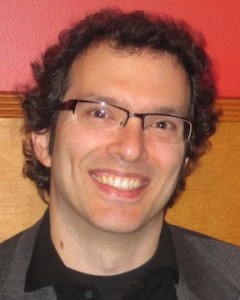I am delighted that Andrew May is our guest blogger today. Andrew  is best known for innovative and subtle chamber music, some of which involves computer-based agents interacting with human performers. He has taught composition and directed the Center for Experimental Music and Intermedia at the University of North Texas since 2005. Born and raised in Chicago, Andrew studied composition with Roger Reynolds, Mel Powell, and Jonathan Berger. His music can be heard on CDCM, SEAMUS, and EMF Media recordings, and his solo CD Imaginary Friends on Ravello Records.
is best known for innovative and subtle chamber music, some of which involves computer-based agents interacting with human performers. He has taught composition and directed the Center for Experimental Music and Intermedia at the University of North Texas since 2005. Born and raised in Chicago, Andrew studied composition with Roger Reynolds, Mel Powell, and Jonathan Berger. His music can be heard on CDCM, SEAMUS, and EMF Media recordings, and his solo CD Imaginary Friends on Ravello Records.
I’m honored to be a guest blogger for New Music Pioneer. I’m a
composer, violinist, computer musician, and teacher in North Texas – like Elizabeth, an avant-garde musician dreaming up the future in the unheralded middle of the country. Right now I’m working on a piece of music that is driving me half crazy with the number of dimensions and details I have to pin down to make it work. What will it sound like? Slow, simple, and beautiful, if all goes well.
Then why one earth am I putting all this work into thousands upon
thousands of details? Part of the reason is the computer; I’m creating interactive performance systems, and computers are morons. To get a computer to make musically intuitive choices that any beginning musician would take for granted requires countless hours of meticulous programming, testing, and tuning. This is a great discipline to remind a composer of just how much goes into interpreting simple music in a simple way. As we enjoy the delicious sound of a great violinist playing a single whole note, we don’t necessarily think of the subtle choices and adjustments of bow pacing, position, and pressure, not to mention the left hand’s vibrato, that bring to life this simple thing that is represented on a page by a single oval. On the other hand, a lack of control could create a very complex sound (the crunching of excessive bow pressure, the multiple skittering repetitions of a note from a shaking bow arm, the slide into the desired pitch if it’s hit out of tune, and so on); the possibility of great simplicity is in fact the result of years of arduous work and intense thought. Likewise, back in the days when a composer expected performers to embellish his music with ornaments, it was understood that a heavily ornamented performance was usually the work of a fool or a charlatan, not a great musician (the same can be said of electric guitar solos, or gospel singing, or any number of present-day examples).
Modern composers’ music is often quite overtly complex. Since I’ve
proposed that the performance of something simple is a complex
business, I’d prefer to call this notational intricacy rather than
complexity (I may get in trouble with friends and colleagues for this,
but that’s life on the Web). There are scores that have easily
hundreds of times more instructions per second of music than, for
example, a slow movement by Corelli. What’s striking about the
experience of listening to these works (to take a beloved example,
Brian Ferneyhough’s flute solo Cassandra’s Dream Song) is that the
audible complexity in performance does not reflect the degree of
notational intricacy. Many of the instructions in the score (like
those I give to the computer, actually) have to do with nuances of
timing, dynamics, timbres, and other elements that shade the meaning of the music, but don’t produce lots of individually perceptible events. In a way, this sort of notation is a way of micro-managing the subtle art of performance. Perhaps in some cases it grows from a fear (often justified) that a performer’s approach to new music might lack subtlety. It certainly tests the performer’s technical and mental abilities, which selects a particularly wonderful sort of performer to become a devoted interpreter of this repertoire (I’m thinking of Elizabeth here).
People have sometimes commented that my music looks easier or simpler than it is. I suppose this is deliberate. I want to invite subtlety, not force it – but my music dies without it. That’s why it’s a lot more fun for me to work with a great performer than with a computer – and why even when I do work with computers, there are always live performers involved too: to quote John Cage, “other people think.” If my score elicits thoughts, feelings, intuitions that a performer can bring to the performance (or even ornamentation – I suffer from Baroque envy), then the resulting performance has a layering of complex ideas and actions that no complexity in the world could capture on paper (let alone in software). The simpler the notation, the more room there is for it to elicit subtle and meaningful nuances. The composer’s burden becomes finding the exact right notation (Morton Feldman, the king of deceptive simplicity, set great store by the “notational look” or “notational image” as a primary element of composition). The visual appearance of the score, of an individual note even, speaks volumes to the experienced interpreter. Get it right, and magic can happen. Get it confused, and the performer’s interpretation may be at cross-purposes to the composer’s intention.
All this may help to explain why forward-looking composers (i.e. those who don’t want their music to sound as if it could have been written long before they were born) so often tend toward intricacy. Subtle simplicity requires a great deal of invisible work and painstaking consideration; it also requires intense empathy for the performer, and above all trust that one’s work will be treated with respect and insight. Most composers have had far too many experiences that eroded that trust, and it’s hard to rebuild. It can be comforting to spend those lonely hours in the composer’s studio putting lots of information on the page and trusting that this, at least, will get the job done. Luckily, whatever approach one takes as a composer, there will be some performers who will get it and will run with it. As I once proposed to Frederic Rzewski at the end of a long evening (and he agreed at the time), “it doesn’t really matter what you write as long as it’s played by the right person.” So this truly is not a manifesto for simplicity, or even for subtlety, and it’s certainly not a rant against complexity or intricacy. It’s more a confession to myself that the painfully long hours I spend making minute decisions about the details of something apparently simple – for better or worse – are exactly what I need as a composer.
